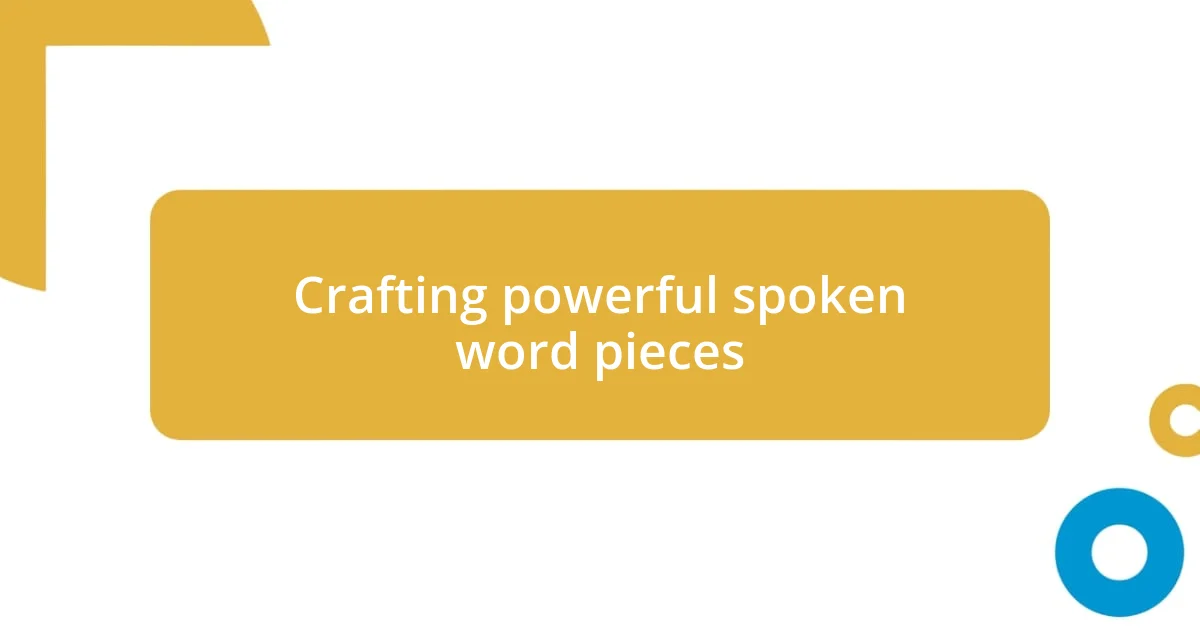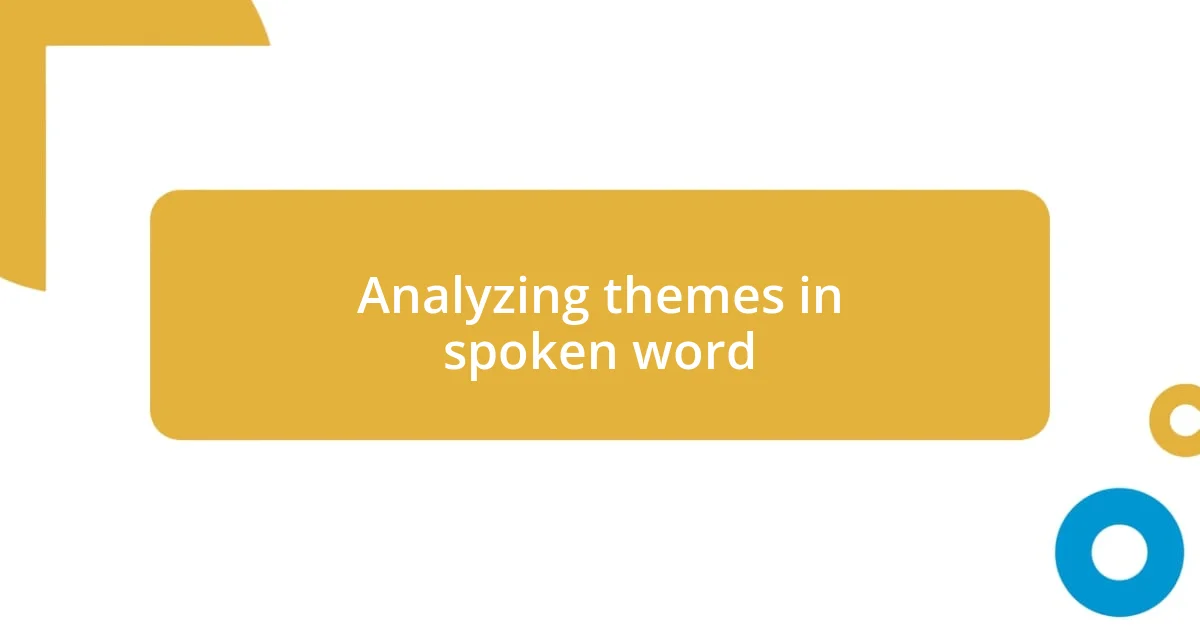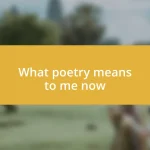Key takeaways:
- Spoken word poetry’s raw emotion and immediacy create powerful connections, addressing themes of identity, social justice, and personal struggles.
- Effective performance techniques include body language, vocal variety, and audience engagement, which enhance emotional depth and create memorable experiences.
- Key themes in spoken word, such as healing and social injustice, resonate deeply with audiences, fostering connection and encouraging collective reflection.

Understanding spoken word poetry
Spoken word poetry stands out as a vibrant form of expression. It’s like music without a melody, where the rhythm comes from the words and the delivery. I remember attending a local slam where the energy pulsed through the crowd; every poem was a unique experience, making me realize how deeply verses can resonate with our shared human experiences.
The beauty of spoken word lies in its immediacy and accessibility. Anyone can step up and share their truth. One evening, I took a chance and shared a piece about loss; the connection I felt with the audience was profound. Does art not thrive best when it’s lived and felt in the moment? The raw emotion of spoken word makes it a powerful medium for storytelling.
Additionally, spoken word often navigates themes of identity, social justice, and personal struggles. I’ve seen poets weave their narratives into powerful commentary on life’s injustices, sparking conversations long after the performance. Isn’t it fascinating how a few carefully chosen words can ignite change or inspire thought? That’s the magic of spoken word poetry—its ability to transform simple stories into impactful voices that demand to be heard.

Importance of rhythm in poetry
Rhythm is the heartbeat of poetry, creating a flow that guides both the poet and the audience. I’ve often found that a poem without rhythm can feel flat, lacking the pulse that energizes the words. In one performance, I watched as a poet skillfully adjusted their pace, drawing listeners in with a slow, deliberate delivery before launching into a rapid-fire crescendo that had everyone hanging on every syllable. This shift not only grabbed attention but also enhanced the emotional impact of the piece, transforming the entire atmosphere of the room.
- Rhythm establishes a pattern that makes the poem memorable, helping to embed it in listeners’ minds.
- It creates a musicality that can evoke emotions, often amplifying the poem’s themes.
- The interplay of rhythm and silence can build tension and release, creating a powerful dynamic in spoken word.
- Just like in music, changes in rhythm can signal shifts in tone, signaling deeper meanings beneath the surface.
- A well-crafted rhythm can also enhance the poet’s voice, making the performance more engaging and authentic.

Techniques for effective performance
When performing spoken word poetry, body language plays a crucial role. I’ve realized that gestures can amplify the emotions conveyed in the words. For instance, during my first performance, I noticed how the slightest hand movement captured the audience’s attention, making them lean in closer. It’s like each gesture adds a visual layer to the poem, reinforcing the message and inviting a deeper connection with listeners.
Vocal variety is another technique that can transform a performance. I often experiment with pitch, volume, and speed to convey different moods and emotions. There was a time I delivered a spoken word piece while varying my voice from a whisper to a booming crescendo. The audience’s reactions were palpable; it’s as if I painted a soundscape that allowed them to feel the highs and lows of the narrative more intensely. Utilizing vocal dynamics not only keeps the audience engaged but also effectively communicates the underlying emotions of the poem.
Building a connection with the audience is key. I remember a performance where I made eye contact with different audience members, which created an unspoken bond throughout the room. When I shared personal stories, I could see nods and smiles, affirming that they were truly engaged. This interaction transforms the performance from a monologue into a conversation, making the experience more memorable for both the poet and the audience.
| Technique | Description |
|---|---|
| Body Language | Use gestures to emphasize words and emotions for deeper audience connection. |
| Vocal Variety | Change pitch, volume, and speed to enhance the emotional depth and engagement. |
| Audience Connection | Make eye contact and share personal stories to foster an interactive experience. |

Crafting powerful spoken word pieces
Crafting powerful spoken word pieces involves infusing your personal narrative with authenticity and vulnerability. I’ve found that when I share my own experiences, the audience not only relates, but they also connect on an emotional level. Reflecting on a night when I unveiled a deeply personal story about loss, I could hear the room shift in energy; it was as if we were breathing together, caught up in the shared weight of those moments. Isn’t it intriguing how bare honesty can transform a piece from mere words into a heartfelt experience?
Words alone, though essential, become a different beast when paired with vivid imagery. During one performance, I painted a picture with my words about an old neighborhood that both comforted and haunted me. As I spoke, I noticed faces light up with recognition or empathy; it was a collective memory we all shared, even if different in details. Crafting those images felt like inviting the audience into a world they could see, hear, and even feel—all weaved together by my voice.
Finally, the importance of pacing can’t be overlooked. I’ve often experimented with pauses to let certain phrases resonate. I remember a moment in a recent performance where I paused right after declaring a pivotal line, and you could almost hear a pin drop. That silence allowed the weight of the words to sink in, and I could feel the audience hanging on the edge of their seats. Doesn’t it make you wonder how much power lies in those brief moments of stillness? The art of spoken word lies not just in what you say, but in how you say it, creating a tapestry of sounds, silences, and emotions that truly captivates.

The role of audience engagement
Engaging the audience is absolutely vital in spoken word poetry. I remember one performance where I encouraged the audience to clap along during a particularly rhythmic section of the poem. The collective sound created an electric atmosphere, amplifying the energy in the room. It was that simple act of involvement that transformed the performance into a shared experience, reminding me how vital it is for poets to invite their listeners into the rhythm and flow of their words.
The reactions of the audience can often guide a poet’s performance in real-time. During a set, I noticed a few people in the front row visibly moved by a certain line about resilience. Their expressions fueled my passion; I instinctively leaned in closer and adjusted my delivery to emphasize that moment. Isn’t it fascinating how a poet can sense the audience’s emotional pulse and then adapt to connect on a deeper level? This dynamic interaction enriches the performance and creates a rhythm between the performer and the audience that can evoke powerful emotions.
I’ve also learned the power of silence as a tool for audience engagement. There was a moment in a recent piece where I chose to pause right before an impactful statement. The anticipation in the air was palpable; I could literally feel the audience waiting with bated breath. That shared stillness set the stage for what came next—an explosion of emotion that echoed through the room. Such moments remind me that being present and aware of the audience’s energy is as crucial to delivering a compelling performance as the words we choose to say.

Analyzing themes in spoken word
When I dive into analyzing themes in spoken word, I can’t help but notice how diverse yet interconnected these themes can be. For instance, during a piece I performed about identity, I explored layers of cultural heritage and personal struggle. As I navigated through my own experiences of finding belonging in two worlds, I felt the audience grappling with their own reflections—have you ever considered how your roots shape your view of the world? It’s a question that resonates deeply for many.
Another significant theme I find captivating is social injustice, a subject that often fuels my performances. I recall sharing a piece that tackled systemic inequality, using stark imagery and metaphor to convey the urgency of the matter. The audience’s murmurs of recognition reminded me that art has the power to raise awareness—how can we remain silent when such pressing issues surround us? It became clear that spoken word transcends mere expression; it ignites a fire in us to confront uncomfortable truths together.
Then there’s the theme of healing, which is especially close to my heart. I once crafted a piece centered around the journey of overcoming trauma, where each line felt like a step toward liberation. I vividly remember the moment I paused to let the weight of a particularly raw line sink in; I could see some audience members wiping tears, their vulnerability mirroring mine. Isn’t it powerful how sharing our vulnerabilities can foster connection and understanding? In those moments, it becomes evident that spoken word serves not just as a means to express pain, but as a pathway to collective healing and hope.












